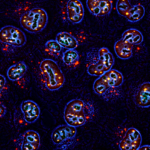Link to Pubmed [PMID] – 34251549
Link to DOI – 10.1007/s00705-021-05149-0
Arch Virol 2021 Sep; 166(9): 2529-2540
RT-qPCR detection of SARS-CoV-2 RNA still represents the method of reference to diagnose and monitor COVID-19. From the onset of the pandemic, however, doubts have been expressed concerning the sensitivity of this molecular diagnosis method. Droplet digital PCR (ddPCR) is a third-generation PCR technique that is particularly adapted to detecting low-abundance targets. We developed two-color ddPCR assays for the detection of four different regions of SARS-CoV-2 RNA, including non-structural (IP4-RdRP, helicase) and structural (E, N) protein-encoding sequences. We observed that N or E subgenomic RNAs are generally more abundant than IP4 and helicase RNA sequences in cells infected in vitro, suggesting that detection of the N gene, coding for the most abundant subgenomic RNA of SARS-CoV-2, increases the sensitivity of detection during the highly replicative phase of infection. We investigated 208 nasopharyngeal swabs sampled in March-April 2020 in different hospitals of Greater Paris. We found that 8.6% of informative samples (n = 16/185, P < 0.0001) initially scored as "non-positive" (undetermined or negative) by RT-qPCR were positive for SARS-CoV-2 RNA by ddPCR. Our work confirms that the use of ddPCR modestly, but significantly, increases the proportion of upper airway samples testing positive in the framework of first-line diagnosis of a French population.











